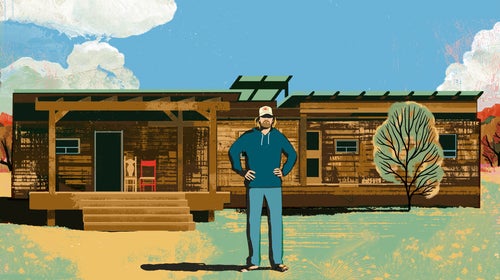Notes from a Moab Trailer
What I learned about love, loss, and landscape over two decades of living in a 1961 Artcraft mobile home in the Utah desert
Heading out the door? Read this article on the Outside app available now on iOS devices for members! Download the app.
In 1993, while squandering a perfectly good college degree, I washed up on the shores of the Colorado River in the sweltering hamlet of Moab, Utah, and found work as a river guide and dishwasher. I was 22. I’d left San Francisco, where, like other English majors, I had hoped to find the writer’s life but instead worked bad jobs to pay rent, which back then was $350. Exorbitant, I thought. In the desert, I fell in with a circle of rock climbers, Jack Mormons, Navy vets, survivalists, earthen-home builders, truant teenagers, cowboys, a Broadway dancer, a Bryn Mawr art history major, and a petite international relations Ph.D. rowing rafts for $50 a day. Most of the people I knew drifted in for a season, hustled tips on the river or in diners, shacked up in tents and buses, then drifted off again.
I’d been invited to dinner at the home of one of my fellow guides, and when I stepped onto the creaky floorboards of the old cottage, I discovered a woman in jeans and sandals and a sleeveless shirt stirring soup on the stove. Her shoulders and hair were bronzed by the sun. She was tall and lean, with chiseled cheekbones, a square jaw, and flinty green eyes. She offered me a bowl of miso soup, and though I’d been raised in Los Angeles—I was no rube—I didn’t know what it was.
“Fermented soybean paste,” she said with a kind of irony, perhaps embarrassed to possess this knowledge.
It was delicious. To this day, whenever I have a bowl, I think it was she who invented it.
Wendy was a decade older than me and, unlike the rest of us, presented as an actual adult. She owned a business and a Toyota 4Runner and had worked on fishing boats in Alaska. I, meanwhile, lived in my station wagon and dated a 17-year-old. For most of the year, she stayed a few hours away, near Telluride, Colorado, living with a full-grown man named Buck, who had a beard and a braid down his back. Buck was an artist. Together, they had opened a shop on Main Street in Moab to sell his screen-printed shirts.
Wendy and I took a walk together one afternoon, high on a windswept red mesa studded with piñon and juniper. With the given name of Frances Wendell, she had a pedigree particular to the American West, unlike anyone I’d met in the suburbs of L.A. Her mother was a Seven Sisters blue blood who’d gone to a Montana dude ranch one summer in the 1950s and fell in love with a strapping son of the owners. She married and stayed there on a ranch on Hanging Woman Creek, a name so arch-western that not only could I not make it up, but Louis L’Amour chose it as a novel title. Wendy and her brothers moved from ranch to ranch, and she came of age in a settlement called Emigrant, in Montana’s Paradise Valley, where she rode her horse to school and was crowned rodeo queen. After getting a college education nearby, she found herself engaged to the scion of a cattle empire who listened to Bach in his Mercedes. Wendy spent the engagement clinically inseminating prize heifers and anticipating an entire life of the same.
Then the rodeo came to town.
Wendy met a clown. She described him to me as the desert breeze blew in her hair, her eyes glossy. “He had a Fu Manchu mustache and an eight ball of coke. We took off in a Porsche,” she said. “The next day, we were in Canada.”




